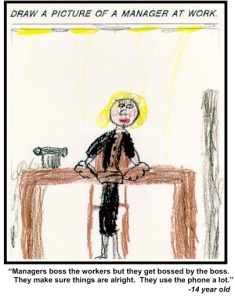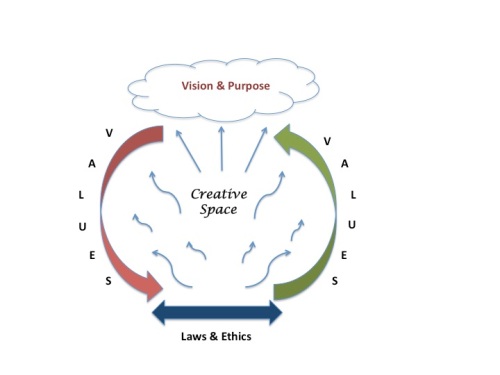 Recently, I read an interesting article that started me thinking about the messages we send out to our children concerning what it is to be a manager. I was thinking too, or perhaps worrying, that in spite of herculean efforts on the part of many ‘experts’ to change the perception of what it takes to be a good manager, we seem to be failing to convey a more enlightened message than the one that prevailed at the beginning of the Industrial Age.
Recently, I read an interesting article that started me thinking about the messages we send out to our children concerning what it is to be a manager. I was thinking too, or perhaps worrying, that in spite of herculean efforts on the part of many ‘experts’ to change the perception of what it takes to be a good manager, we seem to be failing to convey a more enlightened message than the one that prevailed at the beginning of the Industrial Age.
The Article, written by Hal Gregersen for Businessweek.com is entitled, “What Do Managers Do at Work?
Gregerson and his colleague, Warner Woodworth, collected data from one thousand children between the ages of five and eighteen years old. When asked, “What do Managers do at work?” the responses looked like this:
55%: Managers control people’s actions at work, making sure they do what they’re supposed to do when they’re supposed to do it.
39%: Managers fix problems at work, any problem (and more often than not, they fix every problem).
6%: Managers develop people’s capabilities by coaching them to become better at what they do.
Less than 1%: Managers understand and serve customer needs.
Less than 1%: Managers make a profit for their companies.”
While I don’t think the sample size here can wholly represent the perceptions of all children in the five to eighteen age range, it appears that among these 1,000 children, the perception of management remains largely entrenched in a command and control model. And that is worrying enough to talk about.
For me, it begs the question: What must we do to change the record… to make sure upcoming generations of organizational leaders have the opportunity to think differently about the work of leadership and management long before they even get their first job?
It’s a big question. I don’t have the answer…just a thought for now, which is this:
Changing the way we talk about our own work experience might provide an opportunity for the next generation to think about work differently, not necessarily how it is, but how it could be or how we want it to be. ~ If we think young people are not listening when we talk about our jobs, our bosses, or our employees, we would be wrong. That means our experiences around leadership, control, problem solving, idea-generation, diversity etc. are, almost always passed along and absorbed.
So, here are a few questions to ask ourselves that might help us to think differently; to change the conversation; and perhaps too, the perception of what a good manager does at work:
What kind of boss would I like my daughter or son to be?
In what way can I champion a positive and collaborative leadership model?
Why is it important?
What opportunities might I provide now that will help my children develop 21st Century leadership skill?
What kind of role model am I?
Alan Keightley said, “Once in a while it really hits people that they don’t’ have to experience the world in the way they have been told to”
With that in mind, I assert that our children do not have to experience organizational life in the same way so many of us do, or have done. But, for a new vision of leadership to fully emerge, we have to start by breaking old patterns…and changing the record. Fortunately, there is some evidence of this happening. Take a moment to listen to these children on the topic of leadership:
That’s what I think anyway. What do you think?
*Note: This post is a refreshed version of one written in October 2012

 In life and work, there are many boundaries, personal ones,interpersonal ones and systemic ones. And there are also organizational boundaries. These are the ones that intrigue me most because they are the most difficult to manage and yet can be just the thing that makes growth and success possible.
In life and work, there are many boundaries, personal ones,interpersonal ones and systemic ones. And there are also organizational boundaries. These are the ones that intrigue me most because they are the most difficult to manage and yet can be just the thing that makes growth and success possible.

 Making the Shift to Leadership
Making the Shift to Leadership Recently, I watched a movie called
Recently, I watched a movie called 
 The other day, while channel surfing, I caught a glimpse of
The other day, while channel surfing, I caught a glimpse of  I read an article in the Globe and Mail this week entitled,
I read an article in the Globe and Mail this week entitled, In life and work, there are many boundaries. For example, there are personal ones; interpersonal ones and systemic ones, just to name a few. And then there are organizational boundaries. These are the ones that intrigue me most because they are the most difficult to manage and yet can be just the thing that makes growth and success possible.
In life and work, there are many boundaries. For example, there are personal ones; interpersonal ones and systemic ones, just to name a few. And then there are organizational boundaries. These are the ones that intrigue me most because they are the most difficult to manage and yet can be just the thing that makes growth and success possible. Anyone who has been in a leadership role for longer than, oh, five minutes, knows that it is not a prescriptive thing. As simple as we try to make it with lists of the ten top things to do here or the best five things to do there, it remains complex, ambiguous and often contradictory.
Anyone who has been in a leadership role for longer than, oh, five minutes, knows that it is not a prescriptive thing. As simple as we try to make it with lists of the ten top things to do here or the best five things to do there, it remains complex, ambiguous and often contradictory. While rifling through my personal files this week, I came across my last performance appraisal. It was a flattering one so I guess that’s why I kept it. It was also twelve pages long. Twelve pages!!!
While rifling through my personal files this week, I came across my last performance appraisal. It was a flattering one so I guess that’s why I kept it. It was also twelve pages long. Twelve pages!!!
